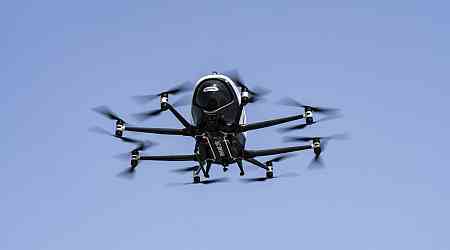
After 27 years of developing airliners, my involvement in electric aircraft started suddenly one afternoon in February 2017. I was asked to comment on the eHang 184, a Chinese passenger drone, which could in theory provide automated taxi services in Dubai. The oft-quoted part of the resulting article will probably appear in my obituary.
[time-brightcove not-tgx=”true”]“Dr. Wright added that he would not be volunteering for an early flight. ‘I’d have to be taken on board kicking and screaming.’”
My first contact with Chinese flying cars, or electric vertical take-off and landing (eVTOL), proved to be indicative in the years since. China has flown high with the nascent technology. One of the biggest developments came in April when the Civil Aviation Administration of China (CAAC) awarded a “production certificate” to EHang’s EH216-S, the first time an eVTOL received such approval anywhere. The move opens the door to a commercial rollout. But other firms are also eyeing the skies. The CarryAll eVTOL from AutoFlight, another Chinese firm, obtained a “type certificate” in March from CAAC, a key step toward regulatory approval. Other homegrown Chinese competitors like XPeng and Vertaxi are also creating buzz.
Indeed, China today accounts for some 50% of the world’s eVTOL models. The government has also pledged to create economic “demonstration zones,” though details remain murky.
Clearly, China is ahead in the eVTOL race. Why is that, and will this lead be sustained? To answer, we must consider the two great challenges facing all the competitors in the field: one posed by technology, the other by humans.
The first challenge is easily stated: new battery technology unlocked the eVTOL era but is now its greatest limitation. Batteries are still only capable of storing and delivering a small fraction of the energy of gasoline, our old friend and nemesis. Until another breakthrough in battery technology occurs, the industry will be limited to premium services in niche applications. Put another way, when and if a new battery wave breaks over the industry and scatters the competitors, the side that rides that wave will take the far greater prize. China is well positioned here, but perhaps the West, with its longer experience of conventional aircraft, could regain the lead.
Now to the second, more elusive, challenge. China is the undisputed king of small-scale consumer drones, but there is a vast gulf between them and conventional passenger aircraft. This is in a field dear to most of us every time we board a flight: reliability. How big is that gulf? The answer is about a factor of 1 million, and the methods and technology to bridge this “gap of six zeroes” are only won with decades of experience. Here the West is certainly ahead with its mature aviation industries and governing bodies.
So, can China jump this “gap of six zeroes”? Probably, in due time. Here I point to the example of the Comac C919, an airliner with an uncanny resemblance to the Airbus A320 and Boeing 737, the most intensely competitive segment of the airline market. The C919’s birth was long and painful, backed with the enormous weight of the Chinese state. Despite a bumpy ride, the C919 has survived and is now entering passenger service.
When it comes to eVTOLs, the new technologies of this brave new world are acting as a great leveller, with all sides scrambling to come up with a whole new set of questions that need to be asked, further eroding the West’s historic advantage in aviation. This point stretches further: the West’s history can sometimes act as a hindrance, as there is a well-founded temptation to try and assess these new machines in terms created around familiar designs such as helicopters and light aircraft, and China could use this as another opportunity to get ahead.
The idea of flying cars is great fun, of course, and I’m glad that I live in a world where these machines exist. But I do not think that they represent the future of mass personal air transport beyond a niche slightly larger than that of today’s helicopters for the rich. The industry is probably going to look more like our existing budget air travel, with “sub-regional” airlines operating from quite large public spaces, and looking less glamorous than I would like, with price searches on booking sites, lines, and baggage checks.
Finally, the tribulations of creating eVTOLs can distract from a related wave that exploits the same technologies and plays to China’s existing strengths: unmanned aviation.
The conflict in Ukraine has provided a brutal demonstration of the massive potential here, with attacks being carried out deep into both side’s territory. The combination of repurposing passenger eVTOLs for cargo-only transport is a sweet spot for electric aviation. I look forward to the flying delivery trucks of the future more than the taxis.
Watch this (air)space…

























